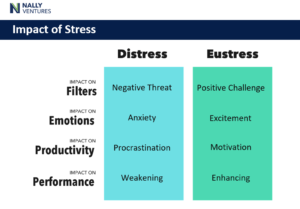
How resilient leaders manage stress: 9 techniques to use
Trying to eliminate stress is a losing proposition. Instead, aim for mindful stress management.
Being a resilient leader means being able to lead in an imperfect environment. Imperfect environments are inherently stressful. You can’t change that. But you can manage stress productively if you learn to recognize and own your stress triggers and stress reactions.
Did you know that some stress is actually positive?
In short bursts, stress can be helpful and positive. Called “eustress,” this mostly acute form of stress causes surges of adrenaline that are good for you. Eustress helps you meet a challenge, like avoiding danger (“fight or flight” response), playing sports, or taking a test. Being able to channel eustress is what makes it productive, giving you energy and increasing motivation.
On the other hand, we have negative stress, or distress.
Distress refers to both episodic acute stress and chronic stress. Distress stems from situations that can’t be changed for long periods of time or from your own negative thoughts or behaviors. Distress is extreme anxiety, sorrow, or pain, and is negative on all fronts.

One of the reasons eustress is positive is that it ends. We have a burst of activity and then rest, completing the “stress cycle.” But in today’s world, chronic stress is more prevalent. We don’t take enough time to rest and reset, and the stress cycle keeps going with no end.
Conquering stress starts with awareness.
Chronic stress is damaging mentally and physically. Overcoming its harmful effects begins with understanding. What does stress feel like to you? What are some typical situations that cause you stress? If you can recognize your stress responses and triggers, you can be ready to take steps to overcome it.
These techniques, most of which you can do on your own, can help you better process stress and avoid its harmful effects.
- Reframe your stress. Reframing is a technique to understand what you’re experiencing and channel it in more productive ways.
- See it. What are you feeling? Heart pounding? Sweating? Anxious?
- Own it. Why are you feeling stressed? Big deadline looming? Too much to do overall? Uncomfortable conversation to have?
- Reframe it. What can you do to process this stress differently? Reallocate resources to meet the deadline? Rebalance your to-do list to focus on what’s essential? Practice the conversation and how it could play out?
- Change it. Deploy your plan and stick to it.
- Get enough sleep and eat healthy.
- Write, draw, or do another creative activity.
- Exercise or spend time outside.
- Read or listen to relaxing music or podcasts.
- Meditate (find a quiet place, sit comfortably, focus on your breath)
- Do mindfulness exercises (take 3 deep breaths; count to 10; close your eyes and notice what you can hear, feel, smell, touch)
- Talk with a trusted person.
- Spend quality time with loved ones.
Not every technique works for everyone, so experiment and see what works for you. The important thing is that you do try them. It can be easy to dismiss stress and try to power through on your own, but left unchecked, stress can easily become overwhelming and damaging.
Being able to manage stress is how you begin to develop psychological hardiness—key to resilience. Don’t let stress master you. Take charge and overcome it.
We work with leaders at all levels—from young leaders-to-be to senior executives—to master stress management and other essentials required to effectively lead and manage others. See more about our offerings.
How can we help your leaders and business excel?
